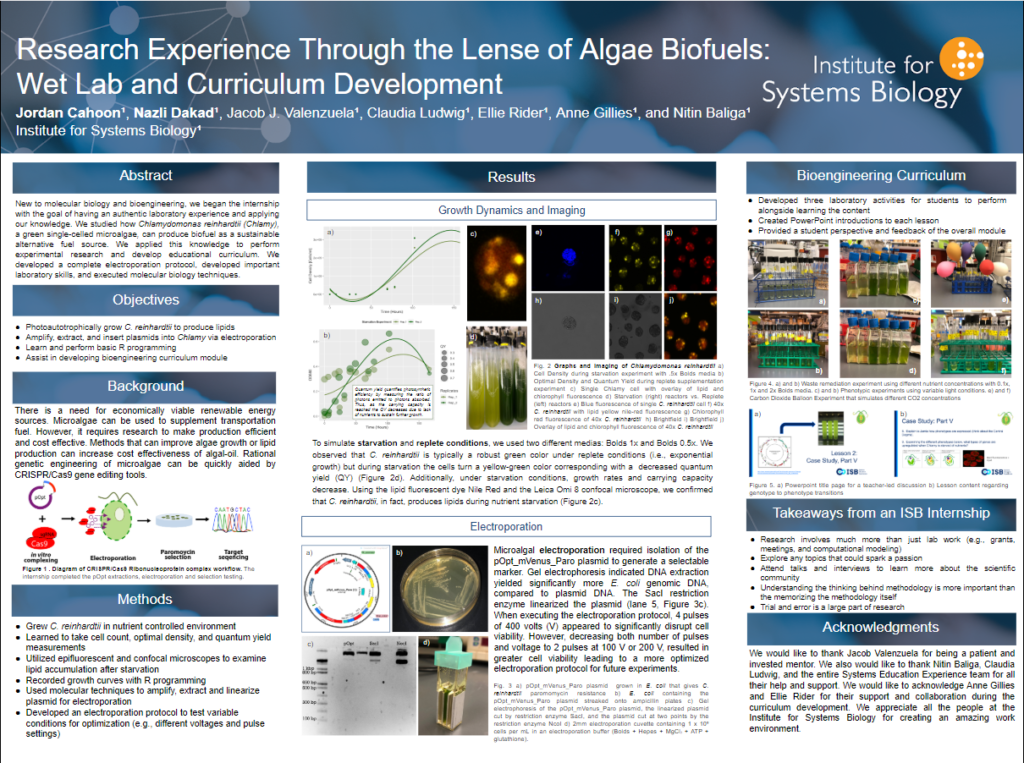Jordan Cahoon and Nazli Dakad
Overview
Background

With the atmospheric carbon dioxide concentration above 405 parts per million and rising, the need for economically viable renewable energy sources has become pressing. Algae-based biofuels hold promise, but an efficient and cost effective method of improving lipid yield from algae is yet to be developed as this fuel is currently at least four times more expensive per barrel than crude oil (Phillips 2018) . Improvement potential in lipid generation from algae lie in strain design, growth and harvesting protocol, and/or refining techniques (López García de Lomana et. al 2015). Because of the information available concerning the genome of Chlamydomonas reinhardtii, strain design for this microalgae proves most accessible (Kong 2019). Though it has been successful in modifying other organisms, CRISPR/CAS9 gene editing protocols for Chlamydomonas reinhardtii need to be researched further to efficiently alter its genes and eventually produce economically viable biofuel (Baek 2016).
CRISPR

Clustered regularly interspaced short palindromic repeats, popularly referred to as “CRISPR,” refer to the adaptive immunity bacteria have harnessed to defend against viruses, where foreign DNA is broken up by Cas proteins and then incorporated into the genome of the bacterium. Recent developments in genetic engineering have utilized this systems, resulting in the CRISPR-Cas9 The system contains two components: single-guide RNA (sgRNA) and the Cas9 protein. Specially designed sgRNA forms base pairs with the specific regions of DNA, while also leading the Cas9 protein to the site of the deletion. Cas9 is able to cleave the DNA, making a double strand cut (Doudna & Charpentier, 2014). The CRISPR-Cas9 system is an efficient and simple way that eliminates the need of specially engineered nucleases such as zinc finger nucleases (ZFNs) and TAL effector nucleases (TALENS). Yet to employ this method, the ribonucleic proteins (RNPs), the sgRNA and the Cas9 complex, need to be transported into the C. reinhardtii cells. This requires a need for an effective electroporation method to ultimately allow genetic alterations.
Electroporation
Previous experiments have discovered that electroporation is the most effective way to introduce genetic manipulations into C. reinhardtii (Kong et. al., 2019). Plasmidial vectors have been found to be cytotoxic and ineffective overall because of continuous expression. Electroporation increases the permeability of the membrane by administering electrical currents allowing the introduction of the CRISPR-Cas9 complex. As a result, the electroporation and RNP method is quicker and more effective than other available processes.
Goals
Develop an efficient protocol for delivery of a Cas9 ribonucleoprotein (RNP) complex in Chlamydomonas reinhardtii using electroporation.
Our Internship
Nazli and Jordan worked with Dr. Jake Valenzuela to develop an optimized electroporation protocol over the summer. To build the necessarily skills to carry out this objective, they learned how to grow and measure Chlamydomonas reinhardtii, perform starvation experiments, graph using R-coding, and molecular biology technique.

Future Developments
Ultimately, as genetic engineering becomes more efficient, scientists focus on lowering the cost of biofuels in C. reinhardtii. Modifications could be increasing the rate of lipid production or by allowing microalgae to produce lipids in a repletion state. As of now, C. reinhardtii can only make lipids in a starvation state, which stunts the growth. Thus, research in the field is centered towards altering C. reinhardtii to grow and make oil simultaneously to optimize biofuel production.
Acknowledgements
We would like to acknowledge Jacob Valenzuela for being a kind and helpful mentor, Claudia Ludwig for directing the wonderful SEE program, Nitin Baliga for allowing us to work in his lab over the summer, and the rest of the Baliga Lab members for giving us guidance throughout our internship.